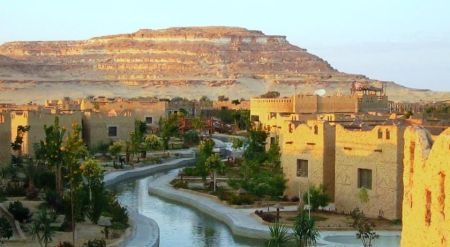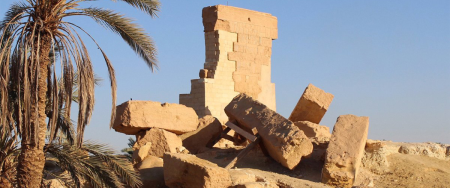Shali Castle

Shali Castle: The Ancient Heart of Siwa Oasis
Shali Castle stands proudly in the center of the Siwa Oasis, a timeless witness to the ingenuity, resilience, and spirit of the Siwan people. This fortress, built of kershef—a mixture of salt, mud, and clay—has guarded the oasis for centuries, offering not just protection but also a sense of identity for the community. Rising dramatically from the heart of the desert, the crumbling yet magnificent ruins of Shali Castle tell stories of ancient civilizations, desert survival, and cultural unity. Travelers who set foot on its pathways can almost hear the whispers of merchants, soldiers, and villagers who once called this stronghold home.
Constructed in the 13th century, Shali Castle wasn’t merely a fortress; it was a thriving city enclosed within thick defensive walls. Its labyrinthine streets, narrow passages, and towering walls were designed to defend inhabitants from raiders and sandstorms alike. Today, Shali Castle remains one of the most mesmerizing historical landmarks in Egypt, a living relic shaped by time and the unforgiving desert climate. As visitors wander through its ruins, they encounter the intersection of architecture and survival, a reflection of how human creativity adapts even in the harshest environments. Exploring Shali Castle isn’t just about sightseeing—it’s about diving into a story that continues to unfold beneath the Siwan sun.
For travelers seeking more than the usual tourist destinations, Shali Castle provides a profound glimpse into Egypt’s lesser-known treasures. While many flock to the Great Pyramids of Giza or the temples of Luxor City, a journey to Siwa and its Shali Castle reveals an entirely different facet of Egyptian history—one carved not in stone but in salt and sand. The charm of this place lies in its authenticity; it’s raw, spiritual, and breathtakingly intimate. Unlike the bustling cityscapes of Cairo city, Shali Castle embodies serenity and a deep connection to nature and tradition.
The Historical Roots of Shali Castle
The origins of Shali Castle trace back to around 1203 AD, when the Siwan people built it to protect themselves from Bedouin attacks and desert threats. The architects relied on locally sourced materials, mainly kershef, which provided both insulation and durability in extreme desert temperatures. The castle’s strategic location in the heart of the oasis made it a vital center for trade and communication. Over the centuries, Shali Castle expanded to accommodate hundreds of inhabitants, complete with homes, mosques, and storage chambers for crops and water.
The structure’s design speaks volumes about traditional Siwan engineering. The thick walls, often over a meter wide, helped regulate temperature, keeping rooms cool during scorching days and warm during chilly nights. The upper terraces offered sweeping views over palm groves, salt lakes, and the distant dunes. This ingenious use of natural resources reflects the deep understanding early Siwans had of their environment. Even after centuries of erosion, Shali Castle continues to awe architects and historians alike. Its construction methods inspire modern eco-builders who seek sustainable approaches to desert architecture.
Architectural Features and Defensive Design
Shali Castle’s architecture was both practical and symbolic. Its spiral alleys created confusion for invaders while allowing residents to navigate easily. The walls were built from kershef blocks mixed with palm trunks, ensuring resilience against wind and sand. Water channels were dug to draw from the oasis springs, essential for survival during sieges. The fortress once had a single gate, reinforcing its defensive function, and a minaret that served as both a lookout and a spiritual beacon.
As visitors explore the remains, they notice how each layer of Shali Castle reveals a story of adaptation. The use of natural salt gave the structure a unique, shimmering appearance when sunlight strikes it. Even in partial ruin, the castle’s charm remains intact—a testament to the artistry of its builders. Preservation efforts now focus on stabilizing what’s left, ensuring future generations can walk through its narrow lanes and imagine life centuries ago.
The Cultural Significance of Shali Castle
More than a fortress, Shali Castle stands as the cultural soul of Siwa. Its walls once enclosed a community bound by tradition, faith, and shared purpose. Inside were dwellings, religious spaces, and markets where locals traded olive oil, dates, and salt. The castle also served as a refuge during desert floods and military conflicts. To this day, many Siwans regard the ruins as sacred, a living reminder of their ancestors’ resilience and unity.
Every corner of Shali Castle echoes with ancient customs. The traditional Siwan language, a Berber dialect, was spoken within its walls, and festivals often revolved around seasonal changes and religious celebrations. The ruins have become a gathering place for local events and storytelling nights, blending historical reverence with cultural continuity. It’s not unusual to see young artisans sketching or filming documentaries here, as the site continues to inspire creativity and pride.
Shali Castle and Modern Tourism
Today, Shali Castle has transformed into a prime destination for cultural and eco-tourism. Visitors who join specialized Egypt Desert Tours often include a stop here to experience the authentic charm of the Siwa Oasis. The Egyptian government and UNESCO have taken steps to preserve the site, stabilizing its fragile walls and promoting sustainable tourism that respects local traditions. Walking tours through Shali’s ruins allow travelers to witness the harmony between history and nature.
As the sun sets behind the dunes, Shali’s silhouette turns golden, offering one of the most photogenic sights in Egypt. The panoramic views from the top of the castle reveal the vastness of the Great Sand Sea and the lush greenery of the oasis below. For those seeking a deeper connection with Egypt’s landscapes beyond the Nile, the castle provides a serene, soul-stirring experience comparable to exploring the White Desert of Egypt or climbing Dakrour Mountain Siwa.
Myths and Legends Surrounding Shali Castle
Locals tell fascinating tales about Shali Castle’s mystical aura. Some believe protective spirits still guard the ruins, while others recount ancient stories about hidden treasures buried beneath its walls. The name ‘Shali’ itself is said to mean ‘city’ or ‘home’, emphasizing its role as the heart of Siwan life. These legends have turned the castle into a symbol of endurance, spirituality, and mystery.
Folklore aside, researchers suggest that Shali’s endurance stems from the unique mineral composition of kershef and the community’s dedication to maintaining it through centuries. Interestingly, some structures inside have survived earthquakes and massive rains that devastated other desert settlements. The castle thus remains a blend of myth and material brilliance, merging heritage with mystery in the sands of time.
Nearby Attractions and Travel Tips
Shali Castle serves as an ideal starting point to explore other landmarks in the Siwa Oasis. Travelers can visit the nearby Mountain of the Dead, the ancient Oracle of Amun, or relax at the fabled Cleopatra Spring. Adventure seekers can take safaris across the dunes of the Great Sand Sea or explore eco-lodges built with traditional Siwan techniques. For history lovers, combining Shali with a trip to ancient wonders like Abu Simbel Temples creates an unforgettable Egypt itinerary.
When visiting, it’s best to wear comfortable clothing suited for desert climates and plan arrival in the cooler months between October and March. The castle is best explored at sunrise or sunset, when lighting enhances its textures and shapes. Local guides often share fascinating insights about the structure and Siwan traditions, enriching the experience for history enthusiasts and photographers alike.
Conservation Efforts at Shali Castle
Preserving Shali Castle has become a priority for cultural heritage organizations. Due to the castle’s fragile kershef material, restoration work must be done carefully, often using the same ancient methods. Local craftsmen play a vital role in these preservation efforts, ensuring that modern interventions don’t compromise authenticity. The revival of Shali reflects a broader movement in Egypt toward sustainable tourism and heritage protection, much like efforts seen at the Grand Egyptian Museum and other major sites.
UNESCO’s involvement and governmental initiatives have helped fund educational programs teaching locals about maintenance and environmental adaptation. These programs have turned Shali Castle into a model of community-led restoration, proving that cultural preservation and tourism can coexist harmoniously. Every repaired wall or stabilized roof represents not just architectural success but also cultural pride and continuity.
Frequently Asked Questions about Shali Castle
1. Where is Shali Castle located?
Shali Castle is located in the heart of the Siwa Oasis in Egypt’s Western Desert, about 750 kilometers southwest of Cairo. It stands at the center of the oasis, surrounded by palm groves and salt lakes, offering spectacular views of the desert landscape.
2. Who built Shali Castle and when?
The castle was built by the Siwan people around the 13th century as a fortified settlement to protect against invasions. Its builders utilized local materials like kershef—a mixture of salt, clay, and mud—making it both functional and environmentally sustainable.
3. What makes Shali Castle unique?
What sets Shali Castle apart is its use of natural salt-based materials and its ability to withstand desert conditions for centuries. Its labyrinth-like design, panoramic views, and historic importance make it a unique fusion of architecture, culture, and sustainability.
4. Can tourists visit Shali Castle today?
Yes. Tourists can freely explore the ruins, often as part of guided eco-tours or Egypt Excursions. While parts of the castle are fragile, safe pathways allow visitors to experience its atmosphere and capture stunning photos of the surrounding oasis.
5. What are other attractions near Shali Castle?
Nearby attractions include the Oracle of Amun, Cleopatra Spring, and Mountain of the Dead. Together, they form a captivating itinerary that showcases Siwa’s blend of history, nature, and spirituality. Visiting these sites alongside Shali Castle offers one of the most immersive cultural experiences in Egypt.







